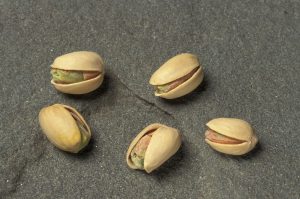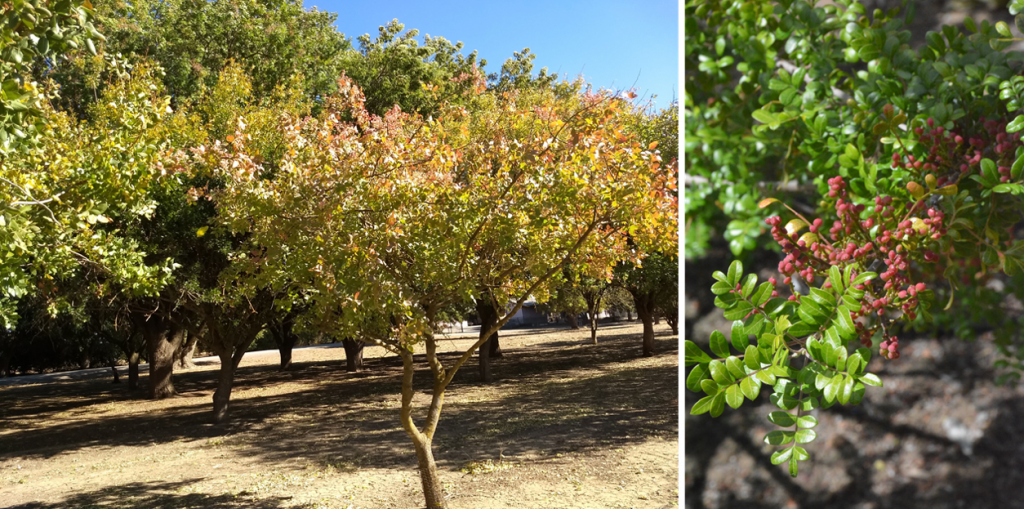Pistachio Collection
John E. Preece, USDA-ARS National Clonal Germplasm Repository, One Shields Drive, University of California, Davis, California 95616
Emma Balunek, USDA-ARS National Laboratory for Genetic Resources Preservation, 1111 S. Mason St., Fort Collins, Colorado 80521
Gayle M. Volk, USDA-ARS National Laboratory for Genetic Resources Preservation, 1111 S. Mason St., Fort Collins, Colorado 80521
Outline
1. Introduction
Pistachios are part of the Anacardiaceae family, also known as the cashew family. There are 11 species in the genus Pistacia. Pistacia vera L. is the only edible species (Ferguson et al., 2005). Pistachios are native to the barren, hot, dry foothills of the deserts in Western Asia and Asia Minor, including countries such as Afghanistan, Iran, and Turkey. California provides the best climate in the U.S. for pistachio production due to its low humidity and hot, long summers. Pistachios are drought and salt tolerant. It takes nearly 20 years for a pistachio tree to reach peak production. The pistachio tree has separate male and female trees, therefore, both male and female trees are required to produce nuts, requiring some males to be planted in every pistachio orchard. The female flowers do not have any petals and therefore do not attract pollinators. Pollen is instead spread by wind (Ferguson et al., 2005). Pistachio trees in the Middle East have been known to produce nuts for over 100 years (Administrative Committee for Pistachios, 2019).
Pistachios are grown on 289,000 acres in the United States, primarily in California. In 2019, utilized production totaled 740 million pounds with a value of $1.94 billion (USDA NASS, 2020). Pistachios are alternate bearing, which means they produce a heavy crop one year and the next year they produce a lighter crop (Administrative Committee for Pistachios, 2019).
Figure 1. Immature fruit of wild (left) and cultivated (right) Pistacia in the U.S. National Plant Germplasm System pistachio collection. Photo credit: Gayle Volk.
Figure 2. Mature pistachios for consumption. Photo credit: USDA Image Gallery.
2. pistacia (pistachio) collection
The U.S. National Plant Germplasm System pistachio collection has 219 accessions of 12 Pistaceae species that are maintained as trees in the field.
Figure 3. Pistachio trees in the field collection of the U.S. National Plant Germplasm System pistachio collection (left) and pistachio tree branch with developing nuts (right). Photo credit: Gayle Volk.
Video 1. Dr. John Preece discusses the pistachio collection.
3. References
Administrative Committee for Pistachios. 2019. Commodity Fact Sheet: Pistachios. California Foundation for Agriculture in the Classroom.
Ferguson L, Polito V, Kallsen C. 2005. The pistachio tree; botany and physiology and factors that affect yield. Pistachio production manual, 4th ed. Davis, CA, USA, University of California Fruit & Nut Research Information Center, 31-39.
USDA National Agricultural Statistics Service (NASS). 2020. Noncitrus Fruits and Nuts 2019 Summary.
4. additional information
Curator: Claire Heinitz, USDA-ARS National Clonal Germplasm Repository, One Shields Drive, University of California, Davis, CA 95616-8607, claire.heinitz@usda.gov
5. Acknowledgments
Citation: Preece JE, Balunek E, Volk GM. 2021. Pistachio collection. In: Volk GM, Preece JE (Ed.) Field tour of the USDA National Clonal Germplasm Repository for Tree Fruit, Nut Crops, and Grapes in Davis, California. Fort Collins, Colorado: Colorado State University. Date accessed. Available from: https://colostate.pressbooks.pub/davisrepositoryfieldtour/chapter/pistachios/
This training module was made possible in part by funding from USDA-ARS, Colorado State University, and the United States Agency for International Development (USAID).
Editors: Emma Balunek, Gayle Volk, Katheryn Chen
This project was funded in part by the National Academy of Sciences (NAS) and USAID, and any opinions, findings, conclusions, or recommendations expressed in such are those of the authors alone, and do not necessarily reflect the views of USAID or NAS. USDA is an equal opportunity provider and employer. Mention of trade names or commercial products in this article is solely for the purpose of providing specific information and does not imply recommendation or endorsement by the US Department of Agriculture.





